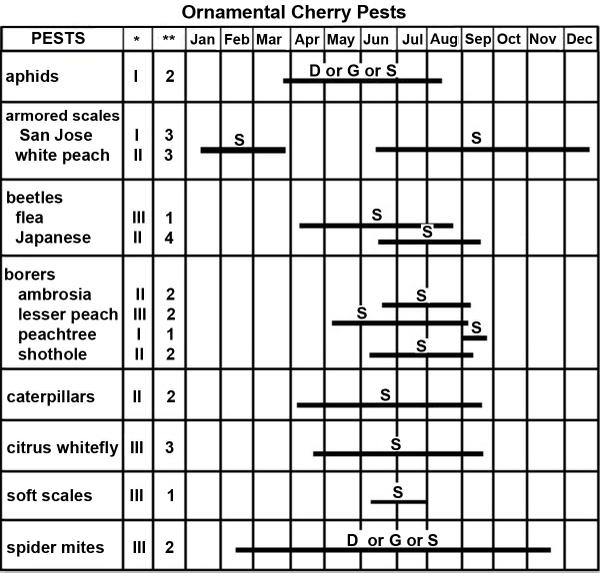Caution
This information was developed for North Carolina and may not apply to other areas.
Please click on the thumbnail to enlarge it or jump to the last section to view an accessible version of the table in HTML format.
Table Legend
* Degree of importance of pest: I = Important pest, high probability of occurrence; II = Treat as needed; III = Occasional pest, treat when detected.
** Number of applications needed for most effective control. It is usually best to wait 10 to 14 days between applications in cool weather and 7 to 10 days between applications in warm weather.
D = Drench; G = Granular; S = Spray application.
Other Resources
- Ambrosia Beetle Pests of Nursery and Landscape Trees. Frank, S. et al. 2019 (revised). Entomology Insect Notes, NC State Extension Publications.
- An Identification Tool for Bark Beetles of the Southeastern United States. Baker, J. R. et al. 2010 (modified). Lucid Key. NC State University.
- Aphids on Ornamental Landscape Plants. Frank, S. 2019 (revised). Entomology Insect Notes, NC State Extension Publications.
- Armored Scale Identification and Management on Ornamental Plants. Frank, S. 2022 (revised). Entomology Insect Notes, NC State Extension Publications.
- Caterpillars That Feed on Trees and Shrubs. Frank, S. and S. Bambara. 2009. Entomology Insect Notes, NC State Extension Publications.
- Citrus Whitefly. Frank, S. et al. 2019 (revised). Entomology Insect Notes, NC State Extension Publications. https://content.ces.ncsu.edu/citrus-whitefly
- Greater Peachtree Borer in the Landscape. Frank, S. et al. 2023 (revised). Entomology Insect Notes, NC State Extension Publications.
- Horticultural Oils for Ornamental Plants. Frank, S. et al. 2023 (revised). Entomology Insect Notes, NC State Extension Publications.
- Japanese Beetles on Ornamental Landscape Plants. Frank, S. and J. R. Baker. 2020 (revised). Entomology Insect Notes, NC State Extension Publications.
- Lesser Peachtree Borer. Walgenbach, J. 2015. NC State Extension Publications.
- San Jose Scale on Ornamentals. Baker, J. R. 2019 (revised). PDIC Factsheets, NC State Extension
- Soft Scale Identification and Management on Ornamental Plants. Frank, S. 2010. Entomology Insect Notes, NC State Extension Publications.
- Southern Red Mite and Spruce Spider Mite. Frank, S. et al. 2019 (revised). Entomology Insect Notes, NC State Extension Publications.
- White Peach Scale Insect. Baker, J. R. 2023 (revised). PDIC Factsheets, NC State Extension Publications.
- Extension Plant Pathology Publications and Factsheets
- Horticultural Science Publications
- North Carolina Agricultural Chemicals Manual
-
For assistance with a specific problem, contact your local N.C. Cooperative Extension Center.
-
This Insect Note has not been peer reviewed.
Ornamental Cherry Pest Management Calendar
The Ornamental Cherry Pest Management Calendar gives approximate dates for pest emergence.
| Pests | Degree of Importance of Pest* | Number of applications** | Jan | Feb | Mar | Apr | May | Jun | Jul | Aug | Sep | Oct | Nov | Dec |
|---|---|---|---|---|---|---|---|---|---|---|---|---|---|---|
| aphids | I | 2 | Drench or Granular or Spray application | Drench or Granular or Spray application | Drench or Granular or Spray application | Drench or Granular or Spray application | Drench or Granular or Spray application | |||||||
|
armored scales (San Jose) |
I | 3 | Spray Application | Spray Application | Spray Application | Spray Application | Spray Application | Spray Application | Spray Application | Spray Application | Spray Application | Spray Application | ||
| armored scales (white peach) | II | 3 | Spray Application | Spray Application | Spray Application | Spray Application | Spray Application | Spray Application | Spray Application | Spray Application | Spray Application | Spray Application | ||
|
beetles (flea) |
III | 1 | Spray Application | Spray Application | Spray Application | Spray Application | Spray Application | |||||||
| beetles (Japanese) | II | 4 | Spray Application | Spray Application | Spray Application | Spray Application | ||||||||
|
borers (ambrosia) |
II | 2 | Spray Application | Spray Application | ||||||||||
| borers (lesser peach) | III | 2 | Spray Application | Spray Application | Spray Application | Spray Application | ||||||||
| borers (peachtree) | I | 1 | Spray Application | |||||||||||
| borers (shothole) | II | 2 | Spray Application | Spray Application | Spray Application | |||||||||
|
caterpillars |
II | 2 | Spray Application | Spray Application | Spray Application | Spray Application | Spray Application | Spray Application | ||||||
| citrus whitefly | III | 3 | Spray Application | Spray Application | Spray Application | Spray Application | Spray Application | |||||||
| soft scales | III | 1 | Spray Application | Spray Application | ||||||||||
| spider mites | III | 2 | Drench or Granular or Spray application | Drench or Granular or Spray application | Drench or Granular or Spray application | Drench or Granular or Spray application | Drench or Granular or Spray application | Drench or Granular or Spray application | Drench or Granular or Spray application | Drench or Granular or Spray application | Drench or Granular or Spray application | Drench or Granular or Spray application |
* Degree of importance of pest: I=Important pest, high probability of occurrence, II=Treat as needed: III=Occasional pest, treat when detected. ↲
** Number of applications needed for most effective control. It is usually best to wait 10 to 14 days between applications in cool weather and 7 to 10 days between applications in warm weather. ↲
Publication date: Jan. 29, 2019
Reviewed/Revised: Nov. 9, 2023
N.C. Cooperative Extension prohibits discrimination and harassment regardless of age, color, disability, family and marital status, gender identity, national origin, political beliefs, race, religion, sex (including pregnancy), sexual orientation and veteran status.

